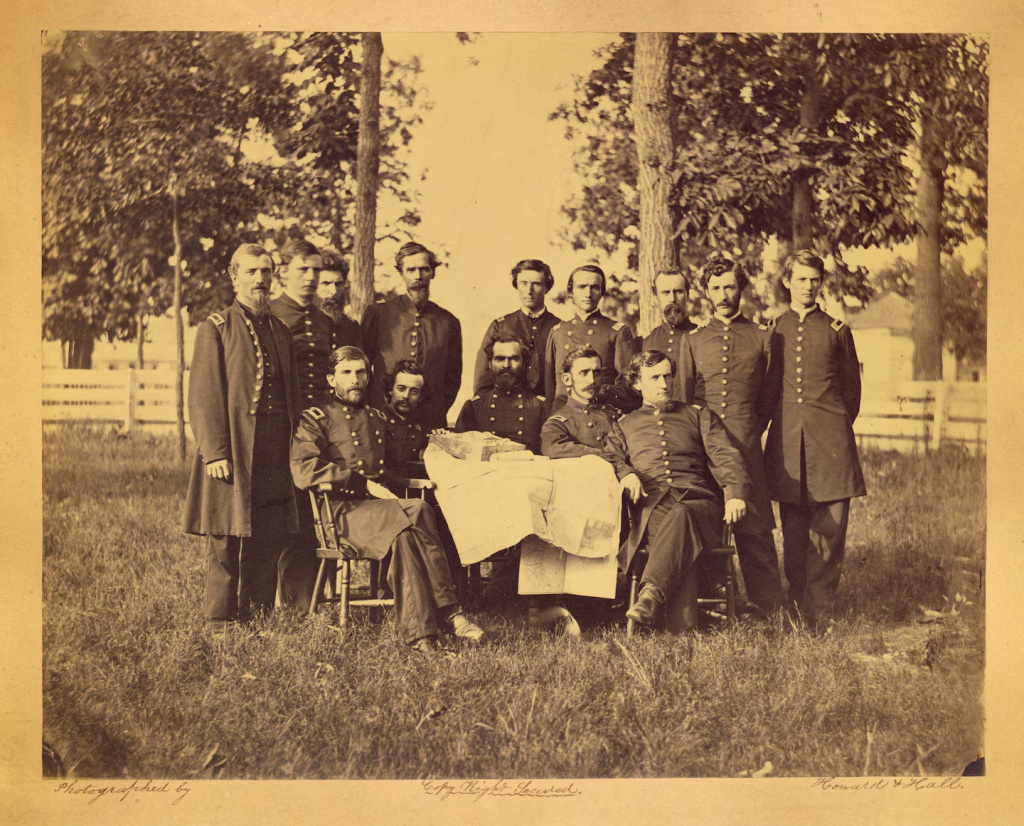-
Binder Clip / Cable organizer
Posted on January 1st, 2024 No commentsI saw this on a forum recently and thought the idea was worth documenting here in my blog:

I am sure no explanation is necessary but several modifications or half clip ideas will manifest from this simple hack.
-
Media Bias Chart End 2023
Posted on December 26th, 2023 No commentsThis is a placeholder that I can refer to as needed: I wish the “Center” bias list was longer but the ones that exist are the ones I read – Mostly.
.
.
.
-
RE-Writing History in the South
Posted on December 20th, 2023 No comments
Alabama farmers who volunteered for the First Alabama Union Cavalry were shaped by its commanders at Corinth, Miss., in 1862. (Grenville M. Dodge Collection/State Historical Society of Iowa) A new generation of Civil War scholars is filling in what one commentator calls the “skipped history” of White Southerners who fought for the Union Army. How did a regiment of 2,066 fighters and spies from the mountain South, chosen by Gen. William Tecumseh Sherman as his personal escort on the March to the Sea, get erased? Here is a link that you can read (or listen to the audio).
-
Journey GD36 Issue
Posted on December 7th, 2023 No commentsI can give you more if you chose Richard

Main AC panel with 50A breaker

Inverter panel

Galvanized box + cabling stbd fwd
-
Two Santa Clauses: Going back in history
Posted on November 19th, 2023 No commentsTwo Santa Clauses Tactic:
Here’s how it works, laid it out in simple summary:
First, when Republicans control the federal government, and particularly the White House, spend money like a drunken sailor and run up the US debt as far and as fast as possible. This produces three results – it stimulates the economy thus making people think that the GOP can produce a good economy, it raises the debt dramatically, and it makes people think that Republicans are the “tax-cut Santa Claus.”Second, when a Democrat is in the White House, scream about the national debt as loudly and frantically as possible, freaking out about how “our children will have to pay for it!” and “we have to cut spending to solve the crisis!” This will force the Democrats in power to cut their own social safety net programs, thus shooting their welfare-of-the-American-people Santa Claus.
Think back to Ronald Reagan, who more than tripled the US debt from a mere $800 billion to $2.6 trillion in his 8 years. That spending produced a massive stimulus to the economy, and the biggest non-wartime increase in the debt in history. Nary a peep from Republicans about that 218% increase in our debt; they were just fine with it.
And then along came Bill Clinton.
Biden – lowered the deficit so far
Trump – raised the deficit dramatically holds the record for largest and 2nd largest deficit in American history
Obama – cut the deficit by about half over his two terms
George W – took us from a surplus to what at the time was the largest deficit in American history
Clinton – took us from a deficit to a surplus
George HW – increased the deficit
Reagan – increased the deficit
-
MIST BPH relief
Posted on October 18th, 2023 No commentsKey Words: BPH, prostate, MIST, Optilume
Benign prostatic hyperplasia (BPH) is a common and progressive disease affecting aging men which has a
significant impact on quality of life. The Optilume BPH Catheter System (Optilume BPH) is a prostatic
dilation system that combines balloon dilation with a localized transfer of paclitaxel to maintain long term
patency. Optilume BPH can be deployed using standard rigid cystoscopy without general anesthesia in an office setting. Prospective data indicate that Optilume BPH has favorable functional and sexual patient outcomes. Readers will familiarize themselves with Optilume BPH, significant historical studies and the technique for deploying Optilume BPHhttps://www.canjurol.com/html/free-articles/2023/30-03/CJU_V30_I3_14_FREE_DrElterman.pdf
-
Robert Reich Oct 10, 2023
Posted on October 10th, 2023 No commentsI’ve spent decades fighting right-wing economists. Yet, like zombies, they and their ideas keep coming back from the dead.
Here’s the latest example.
A surge in long-term interest rates is causing tremors on Wall Street. The yield on the 10-year Treasury note has risen to its highest level since the subprime mortgage crisis began in August 2007…………
-
Galaxy S9 USB Tether
Posted on October 7th, 2023 No commentsTo USB tether the S9 take the following steps:
- Turn on Mobile Hotspot
- Go to Settings from APPS then select Connections tab
- Then select to Mobile Hotspot & Tethering
- Select USB Tethering.
- This will activate the USB output
-
The Spare: A slim book review
Posted on September 4th, 2023 No commentsThe book “The Spare” is a book about Prince Harry’s perspective of his early life, his mother and his exit from royal life. In essence, Harry was forced out by sibling rivalry, a passive Prince Charles (now King Charles) and a bureaucratic, self-serving, sometimes corrupt, and largely money driven cadre of hovering sycophants around the immediate royal family. My view of King Charles and Heir Prince William came out tarnished. My view of the dear departed Queen Elizabeth II remains the same.
I will not spoil the book too much here. The people that read it will find a bunch of self-entitled, well educated people who are blind to realities of common man. It is only when they are in their latter twenties and early thirty’s that the more stereotype, British top royal society images appear.
The book is worth the read and I procured mine via Libby and my Indiana library card. I had to wait about a month. It is an easy to read, fast progressing but filled with recollections book.
-
Bidenomics
Posted on September 2nd, 2023 No comments
The economic numbers for the Biden administration are remarkable and demonstrate the strength of the system under which the government operated from 1933 to 1981: the idea that investing in ordinary Americans builds the economy far more efficiently than so-called “supply-side economics.” That economic ideology, advanced by the Reagan Republicans, claimed that cutting regulations and concentrating wealth at the top of the economy would enable business leaders to invest in the economy efficiently, cutting costs and driving economic growth.
But that vision has never produced as promised, while it has dramatically concentrated wealth and power since it went into effect in 1981. “Bidenomics” is a rejection of that theory and a return to the economic vision that built the country in the fifty years before it. Investing in infrastructure and programs that help ordinary Americans puts money and the power of innovation into their hands, driving the economy from the bottom up and the middle out, as Biden puts it.
View in browser September 1, 2023Heather Cox Richardson



